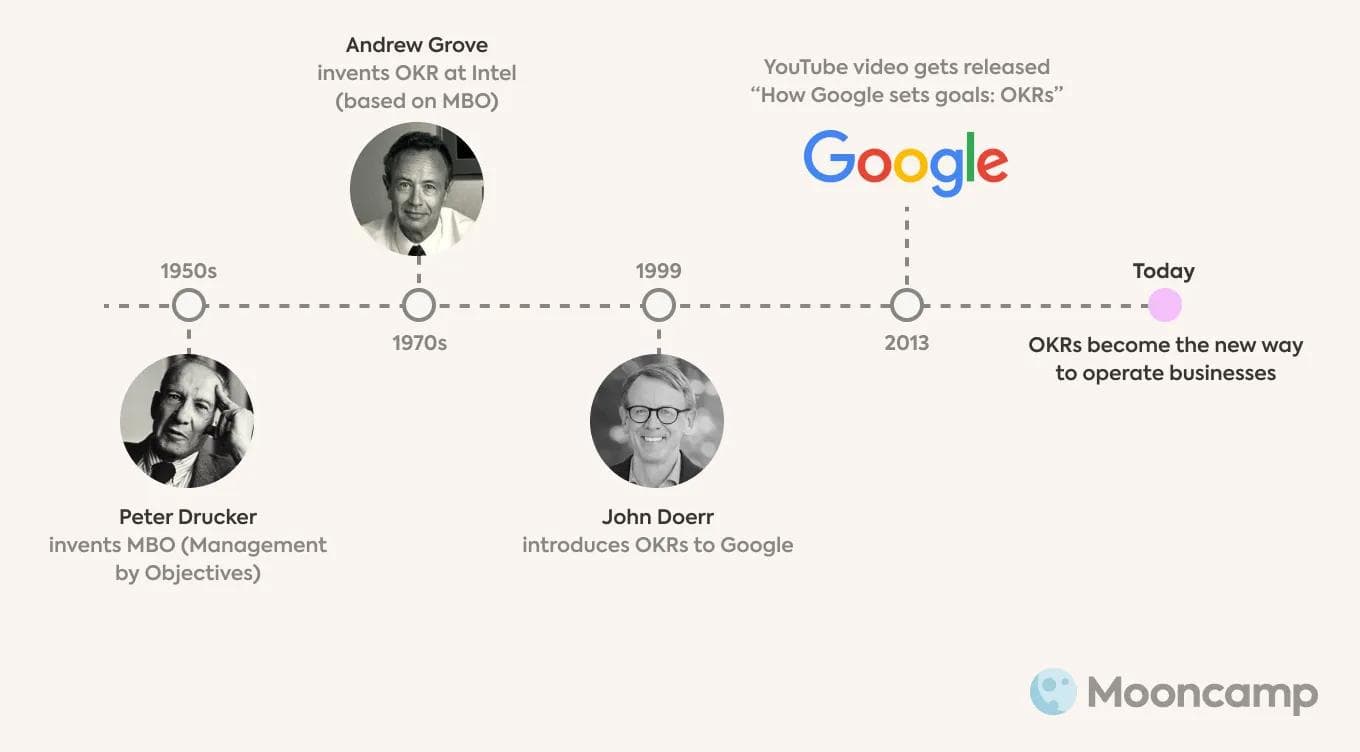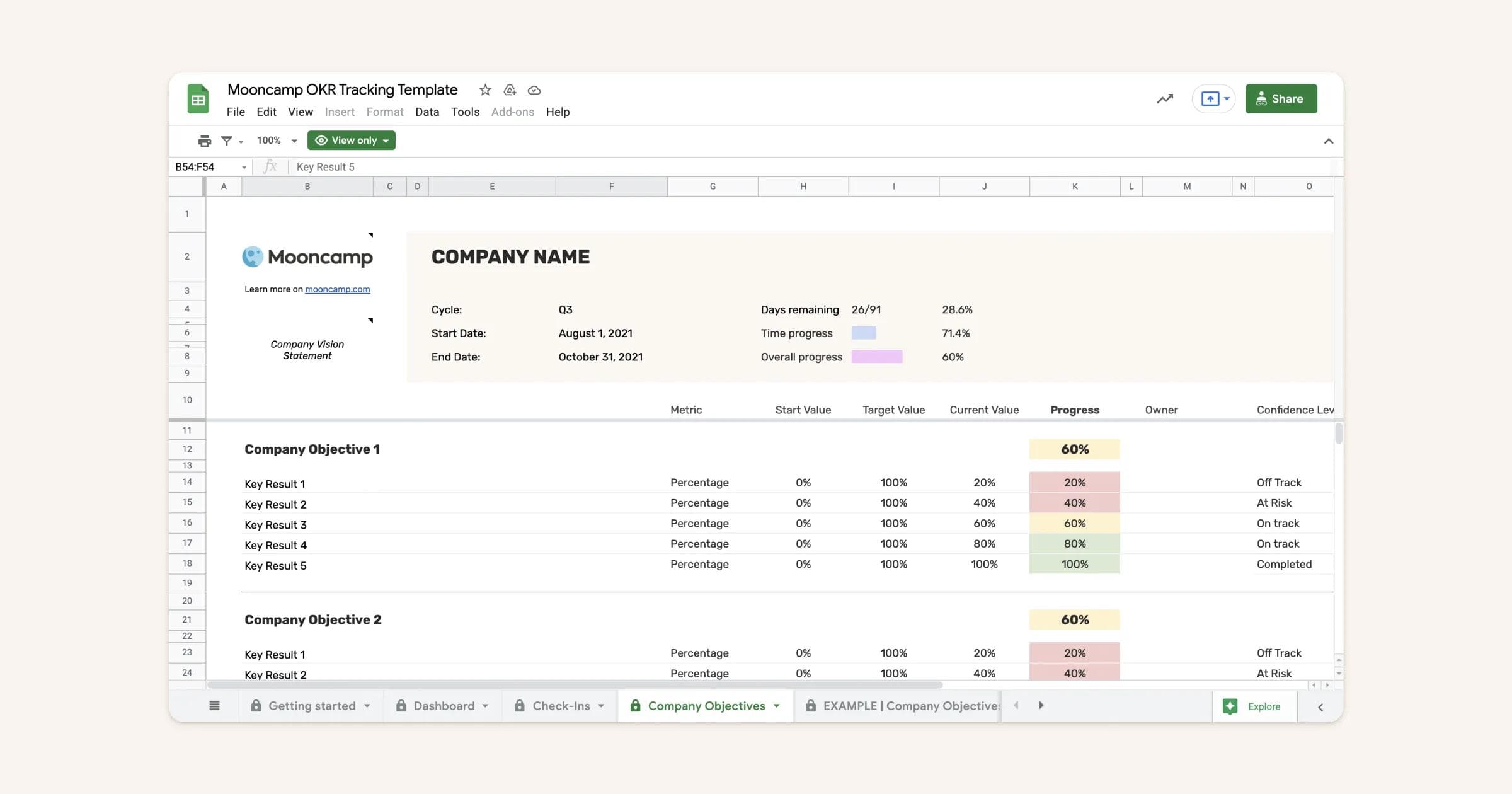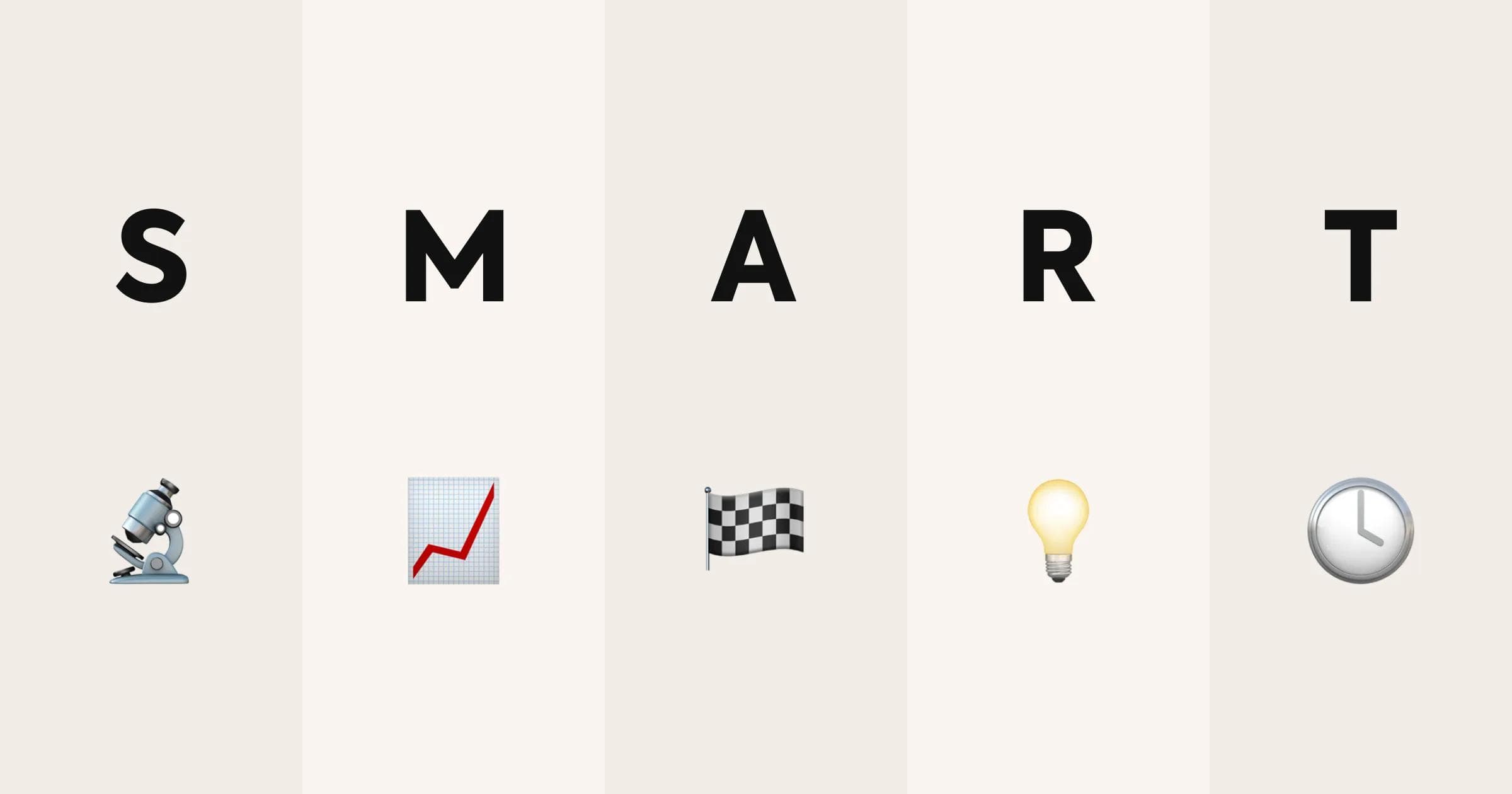What does OKR mean?
OKRs stand for “Objectives and Key Results”. It is an agile goal management framework to set ambitious, measurable goals and enable results-driven outcomes across the whole company.
What OKRs mean for business is manifold: As the OKR methodology is not only used by leadership, but also teams and individuals, it creates transparency, alignment and focus across the whole organization, which in turn leads to higher employee engagement and productivity.
The world of business is full of challenges and change. Companies are continuously exploring various management methodologies to stay on track and focus on what matters. Organizations need clear and well-defined methods and strategies to be able to grow and remain profitable in the long term.
Over the years, many management methods have come and gone, some are dwindling in popularity in a rapidly changing business landscape, while others are thriving – one of these is the OKR methodology, which has steadily grown in popularity since its conception. But many still have the question: “What is OKR and what is the methodology all about?”
In this article, you will learn the meaning of OKR, gain some insights into the history of the methodology, a brief explanation of how OKRs work, and a summary of how they benefit organizations, teams, and individuals.
What to expect:
- OKR meaning: Objectives and Key Results definition
- OKR origin: A brief history
- OKR explained: How do OKRs work?
- Types of OKRs
- What does a good OKR look like? OKR examples
- OKR in business: The benefits of OKRs
- Further OKR resources
- Frequently asked questions
OKR meaning: A definition of Objectives and Key Results
OKR (Objectives and Key Results) is a modern framework for setting goals, leading employees, and executing strategy. It is used by organizations, teams, and individuals to set challenging goals with measurable results.
OKRs enable organizations to track progress towards an overarching mission, motivate employees and create focus and alignment toward goals.
The key benefits of the framework include a better focus on results that matter, prioritizing outcomes over outputs, improved transparency across the organization, and better alignment on a strategic level. OKRs allow for this by choreographing teams and individuals and the work that they do around achieving common organizational Objectives.
The OKR framework includes a number of rules and guidelines which help teams and individuals prioritize, align, and measure the outcomes of their work in a way where they can later reflect, improve and adjust where necessary to have a meaningful impact in the future.
Essentially, OKRs help organizations “bridge the gap” between overall strategy and execution of objectives and effectively transition from an output- to an outcome-driven approach to work.
OKR origin: a brief history

Originating in the 1950s, OKRs came to be from Peter Drucker’s management method “Management by Objectives” (MBO), an earlier methodology still in use today by many organizations.
Andy Grove, an early employee and later CEO of Intel, developed the OKR framework based on Drucker’s MBO methodology in the 1970s and then later introduced it at Intel where it was then implemented and rolled out to the whole organization.
John Doerr, another former employee at Intel, realized the effectiveness of the OKR method and later, after joining one of Google’s early major investors, Kleiner Perkins, introduced it to Google during his time as a consultant to Larry Page and Sergey Brin.
OKRs today
Today, the OKR methodology is being increasingly adopted by small and large organizations alike and has become the new way to operate an organization with keeping agility in mind.

These adopters use OKRs to manage their company goals and in some cases have propelled organizational growth in a way that has allowed them to become industry leaders. OKRs have been implemented in companies such as Slack, Trivago, Netflix, and many more.
The methodology has further developed since its inception and today is a clearly defined framework with experts, consultants, and OKR tools available, such as Mooncamp, ensuring success for those that implement the methodology.
By being able to focus more on goals and the relevant tasks that need to be accomplished to reach them, these organizations have not only survived in a turbulent market environment but thrived, and in the process grown their business and moved their organization into a unified direction, making them great examples to look to.
💡 Did you know: Prior to implementing OKRs, Google was just in its start-up phase with around 40 employees. Enacting strategies for setting and measuring qualitative ambitions and goals at Google on both the team and individual levels helped the organization achieve the level of success it experiences today, growing to over 100,000 employees and becoming the world's preferred search engine.
OKR explained: How do OKRs work?

OKRs consist of two key components: an Objective, this tells you what exactly you want to achieve, and 3 to 5 Key Results, which are what you need to achieve to reach your Objective. Initiatives are then all the projects and tasks that will help you achieve your Key Results.
Objectives
When writing Objectives, ask yourself this:
🤔 “What do I want to achieve?”
An Objective is something that you want to achieve within a set time frame. An Objective sets the direction. They are simple, easy to understand, and qualitative. Objectives are inspiring, motivating, never technical, and should never contain a metric.
Typically, 2 - 4 Objectives are set per team.
Key Results
When writing Key Results, ask yourself this:
🤔 “How do I know if the Objective is reached?”
A Key Result shows you how you are progressing towards your Objective – it is a measurable outcome required to achieve the Objective. They are quantitative, time-bound, and contain a metric with a start and target value.
Typically, 1 - 5 Key Results are set per Objective.
Initiatives
When writing initiatives, ask yourself this:
🤔 “How do I reach the goal?”
Initiatives are all the projects and tasks that teams and individuals undertake along the way to achieving a Key Result. They are activities that are to be carried out and characteristically have a measurable output, are directly controllable and adjustable, and are directly derived from the set OKRs.
Types of OKRs
OKRs are typically one of two things: Committed or aspirational.
- Committed OKRs: At the end of an OKR cycle, a committed OKR is expected to be completely achieved. These are often goals that must be accomplished with the highest priority.
- Aspirational OKRs: Sometimes called “stretch goals” or “moonshots”, these OKRs are not intended to be achieved with 100% success explicitly but are aspirational – they are to encourage teams and individuals to go “above and beyond”.
What does a good OKR look like?
Formulating good OKRs requires some consideration, however, good OKRs all contain the same simple key elements — they are measurable, they are challenging, and they are clear.
- Measurable Key Results: The key to crafting a good OKR is setting one that is measurable. If your Key Results aren’t measurable, it’s hard to track their outcomes and if you’ve been successful. By ensuring that there is a quantifiable way to measure success, i.e. a metric, you can easily track your progress towards the Objective
- Challenging: OKRs should be challenging, as is the case with aspirational OKRs. When formulating a good OKR, reach for the stars. Set them to be attainable, but in a way that motivates teams and individuals to go “above and beyond”. Completing the OKR 100% of the time is not the aim.
- Clear: OKRs should never be over-engineered, they need to be easily understood and executable. The Objective needs to be straightforward and to the point, and the Key Results should show what you’re tracking and how you’re tracking it without the need for further explanation.
OKR examples
🚀 Marketing
💸 Sales
☘️ Human Resources
Check this out: See some OKR examples in action - we have compiled real-world examples of Objectives and Key Results from real companies.
OKR in business: the benefits of OKRs

When talking about the benefits of using OKRs, John Doerr always talks about F.A.C.T.S. – this acronym stands for:
- Focus: OKRs create a clear focus for the whole company. OKRs allow teams and individuals to get behind a small set of strategically set goals and priorities.
- Alignment: OKRs drive alignment within organizations and teams alike, allowing everyone to move in the same direction towards common outcomes.
- Commitment: OKRs foster a culture of collective commitment from everyone involved to choose and stick to agreed-upon goals and priorities.
- Tracking: OKRs allow organizations, teams, as well as individuals, to track their progress towards specific goals and know quickly when to change tactics if falling off track.
- Stretching: OKRs empower teams to set goals that stretch beyond what they believe they can ordinarily achieve in an aspirational way and allow them to make significant, meaningful impacts.
However, there are a number of other OKR benefits for organizations including better organizational agility and adaptability, more autonomy and self-organization amongst employees, more effective communication, as well as much higher levels of employee engagement.

Learn more about OKR benefits on our blog.
Further reading
OKR guide
To learn more about the theory behind the OKR methodology, as well as the application of the framework in practice, check out our OKR guide.
OKR books
If you are just getting started and the methodology is still somewhat alien to you, these OKR books are a good introduction to the OKR method.
What OKRs are not
OKR meaning – FAQ
What is the meaning of OKR?
OKR stands for “Objectives and Key Results”, a collaborative goal-setting framework used by organizations, teams, and individuals to set challenging, actionable goals with results that are measurable. OKRs allow organizations to track progress, motivate employees and create focus and alignment around metric-benchmarked goals.
Who invented and developed OKR?
OKRs developed from Peter Drucker’s management method “Management by Objectives”. Andy Grove, early employee and former CEO of Intel, developed the OKR framework based on Drucker’s MBO methodology in the 1970s and then later introduced it at Intel. John Doerr, another former employee at Intel, realized the effectiveness of the OKR method and later introduced it to Google.
How does the OKR process work?
An OKR consists of 2 key components: an Objective, and 3 to 5 attached Key Results. Initiatives are then all the associated projects and tasks that help you achieve your Key Results. Typically performed quarterly, teams will engage with OKR planning to set Objectives and Key Results for the set cycle. Regular check-ins are performed, usually weekly, to update on progress. At the end of the OKR cycle, reviews are conducted and learnings are taken into consideration to begin planning for the next cycle.
What is an Objective?
An Objective answers the question: “What do I want to achieve?”. Objectives have several key characteristics – they are qualitative, they are simple and easy to understand, and they are inspiring and motivating. Typically, 2 - 4 Objectives are set per team.
What is a Key Result?
A Key Result answers the question: “How do I know that the Objective is reached?”. Key Results have several key characteristics – they follow the S.M.A.R.T criteria. Typically, 1 - 5 Key Results per Objective are set. Key results are also time-bound (year, quarter, …).
What is an initiative?
In addition to setting Objectives and Key Results, many companies also use initiatives. An initiative answers the question: “How do I reach the goal?”. Initiatives have several key characteristics – they are usually a task or activity with a measurable output, they are directly controllable, and are derived from OKRs.
Which companies use OKRs?
From small companies to international conglomerates: OKRs have first been implemented by companies like Intel and Google and are now used by organizations across all industries, such as Amazon, Dropbox, Samsung, Volkswagen, Slack, Trivago, LinkedIn, Netflix, and many more.





